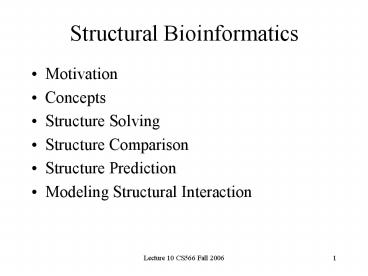Structural Bioinformatics PowerPoint PPT Presentation
1 / 12
Title: Structural Bioinformatics
1
Structural Bioinformatics
- Motivation
- Concepts
- Structure Solving
- Structure Comparison
- Structure Prediction
- Modeling Structural Interaction
2
Motivation
- Holy Grail Mapping between sequence and
structure. Structure F(Sequence) - Structure allows the detailed understanding of
function - Science-Fiction Simulate life as a movie of
molecular interactions
3
Concepts
- Protein and DNA structure of maximum interest,
though growing interest in carbohydrates - Central Dogma
- Primary structure gt Secondary structure,
Tertiary structure gt Function - Primary structure
- The actual permutation, i.e., the sequence per se
- 20L possibilities, but only about 103-4 families
(equivalence classes) - High spatial locality
- Secondary structure
- Helix, Sheet, Loop, Coil
- Intermediate spatial locality Local organization
- Tertiary structure
- Only so many folds
- Evolutionary bias?
- Only so many stable structures?
- Low spatial locality The actual 3D structure
4
Structural Bioinformatics
- Macromolecular complex gt
- Protein gt (No. of species 104)
- Fold gt (103)
- Domain gt (103-4)
- Module gt
- Motif gt
- Residue gt
- Atom
Level of abstraction
5
Primary structure
- Determined
- Experimentally
- Sequencing
- Computationally
- Proteome prediction from genome
- Finite number of real-world families based on
sequence similarity - Significance Sine qua none
- Databases Swiss-Prot, PIR, Genpept
6
Secondary structure
- Determined
- Experimentally
- Circular dichroism, NMR, Raman spectroscopy
- Computationally (Next semester!)
- Sliding window context analysis
- Periodicity analysis
- Significance
- Higher order building block
- Mechanistic significance in protein folding
7
Tertiary structure
- Determined
- Experimentally
- X-ray crystallography, NMR
- Computationally
- Based on similarity to known structures (Homology
modeling) - a priori
- Significance
- Level of abstraction highly indicative of
function - Databases PDB, SCOP, CATH, FSSP
8
Structural representation
- Cartesian coordinates (x,y,z) for each atom in
structure One vector for each atom - Internal coordinate representation (edges,
angles) Set of inter-atom vectors - Visualized in graphical programs as
- Surface representation
- All atoms or just backbone (N-C-C) atoms
- Cartoons Helix, Sheet, Loop shorthand
9
Structure Solving X-ray crystallography(With
apologies to crystallographers)
- Given primary structure, find the tertiary
structure experimentally - X-ray crystallography
- Based on property of electrons to scatter X-rays
- Make big beautiful protein crystal (Like sugar
crystals Slow desiccation of protein soup) - Shoot X-rays through crystal and record
diffraction pattern (Ripples from different
sources forming interference pattern Light waves
too gross for measurement of small interatomic
distances) - Provided phase known, structure can be
reconstructed using Fourier transforms
10
Structure Solving X-ray crystallography(With
apologies to crystallographers)
- Phase information deduced by
- Incorporation of heavy metals into proteins
(Crystals from immersion of protein in heavy
metal soup) - Use of known structures of similar sequences
homology based structure solving - Iterative structure refinement based on matching
simulated data from model and experimental
diffraction pattern obtained - Limitation
- No crystals, no structure!
- Structure is an average over prolonged period of
time
11
Structure Solving Nuclear Magnetic Resonance
Spectroscopy(With apologies to NMR
spectroscopists)
- Basis
- Based on magnetic properties of spinning protons
and neutrons - Different atoms in different (structural)
contexts react differently to magnetic fields - Key elements
- Specially prepared (different forms of N and C)
protein (soup) solution subjected to strong
electromagnetic field to obtain spectroscopic
data - Spectroscopic data interpreted as constraints on
distances between atoms - Simulated annealing used to find best match
between constraints and model
12
Structure Solving Nuclear Magnetic Resonance
Spectroscopy(With apologies to NMR
spectroscopists)
- Limitations
- Set of structures (not unique single solution)
determined - On average, higher error than crystallography
- Solves smaller structures than crystallography
- Bright side of structure-solving
- Algorithms and software well developed
- More powerful sources of X-rays (can work with
smaller crystals and in smaller time periods) and
electromagnets becoming available - Optimized centers exist that can do a structure a
week! - Challenges Higher resolution (The elusive but
all-powerful hydrogen bond), Structures of
complexes (Life is molecular interaction.
Period)

